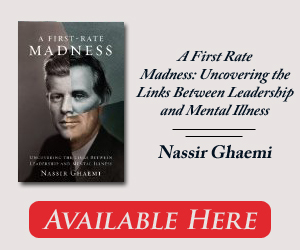A First-Rate Madness: Uncovering the Links Between Leadership and Mental Illness, by Nassir Ghaemi, The Penguin Press, 340 pp., $27.95
Realism. Resilience. Empathy. Creativity. As Nassir Ghaemi argues in A First-Rate Madness, these are not only the traits of effective leaders in times of crisis, they are qualities often exhibited by people suffering from psychological disorders like mania and major depression. Is it any wonder, then, that many of history’s most revered (and most infamous) leaders were mentally unstable? According to Ghaemi, the overlap is more than mere coincidence.
Ghaemi, a psychiatry professor at the Tufts University School of Medicine and director of the mood disorders program at Tufts Medical Center, gives us a series of carefully researched capsule biographies—of Abraham Lincoln, William T. Sherman, Mohandas Gandhi, Winston Churchill, Franklin Roosevelt, John F. Kennedy, Martin Luther King Jr., and, yes, Adolf Hitler, among others—to suggest that leaders often inhabit a kind of looking-glass world in which the inmates are the only sane ones in the asylum. Commendably, Ghaemi diminishes the stigma of mental illness. But with regard to his thesis that, at critical moments, people suffering from mood disorders make better leaders, the devil is in the details.
In support of his assertion, Ghaemi rightfully rejects Freudian psychoanalysis as too theoretical an approach and employs the techniques of evidence-based medicine, paying particular attention to the biology of his subjects: their genetics, brain function, course of illness, and response to treatment. But the book suffers when he ceases to be critical of his own theory. Sherman, Lincoln, and Hitler clearly suffered from documented mental illness, but Ghaemi’s diagnoses of Churchill, Roosevelt, Kennedy, and King are less convincing. He appears untroubled that his argument relies on the use of selected subjects rather than a randomized sample. And he is sometimes careless with detail: the German defeat at Stalingrad, for example, from which he dates Hitler’s mental decline, occurred in early 1943, not “late 1941.”
More problematic is Ghaemi’s reliance on Roy Grinker’s 1962 study of mentally healthy people. The two-year study tracked 65 men attending a YMCA-sponsored college in Chicago, 85 percent of whom showed no signs of psychological distress. In general, they were “upright young men,” Grinker wrote, who were “submissive to authority.” Such a man would be an ideal member of the proletariat, perhaps, but not a natural leader, whom Grinker characterized as “the creative individual who withdraws from his society, returning to lead it in the light of his discoveries.” After citing this flawed study by an intellectually elitist author looking down on churchgoing phys ed majors, Ghaemi largely ignores the subsequent half-century of research that suggests Grinker’s scorn for the normal was unwarranted.
In 1966, when I began work on the study of lives, I, too, believed that the depressed men in the “Grant Study”—the longest-ever longitudinal study of adult life, which tracked 268 Harvard sophomores who began college in the late 1930s—would lead more profound and empathic lives than the 30 percent of the sample who have now reached age 90 without acknowledging or seeking help for any kind of serious mental distress. I was wrong. Several men from the “mentally healthy” group went on to become empathic leaders, some during times of crisis; alas, none of the 20 depressed men did so.
 Of the four traits Ghaemi asserts are valuable for crisis leadership—creativity, resilience, empathy, and realism—the latter two are frequently associated with depression, but the others only in selected cases. Without admitting it, Ghaemi often depends on anecdotal evidence to show creativity’s association with mental illness. By the 1960s, for example, four of the five American men who had received the Nobel Prize in Literature were alcoholics. As a result many people believed booze aided the muse. But as soon as psychohistorians examined a time frame that did not include Prohibition, which made heavy drinking part of a young artist’s life style, and employed greater ethnic and gender diversity in their research sample, the association between creativity and alcoholism vanished.
Of the four traits Ghaemi asserts are valuable for crisis leadership—creativity, resilience, empathy, and realism—the latter two are frequently associated with depression, but the others only in selected cases. Without admitting it, Ghaemi often depends on anecdotal evidence to show creativity’s association with mental illness. By the 1960s, for example, four of the five American men who had received the Nobel Prize in Literature were alcoholics. As a result many people believed booze aided the muse. But as soon as psychohistorians examined a time frame that did not include Prohibition, which made heavy drinking part of a young artist’s life style, and employed greater ethnic and gender diversity in their research sample, the association between creativity and alcoholism vanished.
In similar fashion, most studies that have used anecdotal data to “prove” that unusually creative individuals are often mentally ill have “proved” it. However, systematic studies that incorporate random selection methods invariably find that, except in the cases of poets and playwrights, creativity exists independent of mental illness. In the Grant Study neither alcoholism nor depression was significantly associated with creativity. Moreover, the Grant Study demonstrated that resilience was dramatically associated with “normal” people and negatively associated with depressives—Abraham Lincoln notwithstanding.
Nevertheless, for all the weaknesses of his book, Ghaemi often is on target. He does show from his convincing study of the experimental literature that accuracy of observation is better among the depressed. After 48 years of studying the depressed men described in the Grant Study data, I agree with him that depression often facilitates empathy. And the sections of his book that deal with the study of mania, especially in famous leaders who benefit from just the right amount of it, are enthralling.

